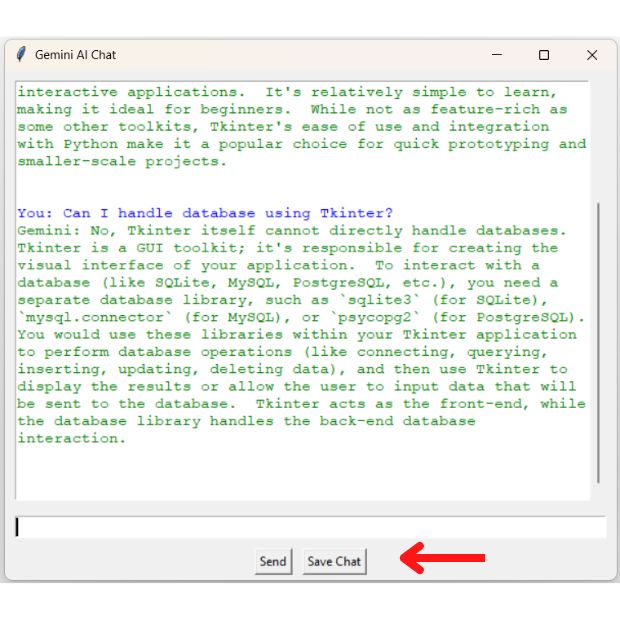Create Your First AI Chat App with Python and Gemini — Desktop GUI in Minutes

In this first part of our Gemini AI desktop app series, we will build a simple chat interface using Python and Tkinter. This app will let you send messages to the Gemini AI model and get responses — just like a basic chatbot. You will also learn how to configure the Gemini API key and run the app locally.
📦 Step 1: Install Required Packages
pip install google-generativeai python-dotenv🔐 Step 2: Create Your .env File
Create a file named .env in the same folder as your Python script, and add your Gemini API key like this:
GOOGLE_API_KEY=your_actual_api_key_here💬 Step 3: Gemini Chat App (Basic Version)
This is the full working script. It creates a Tkinter GUI with a chat window and input box. The app maintains chat context using Gemini’s start_chat() method.
import tkinter as tk
from tkinter import scrolledtext
import os
import google.generativeai as genai
from dotenv import load_dotenv
# Load API key
load_dotenv()
GOOGLE_API_KEY = os.getenv("GOOGLE_API_KEY")
# Configure Gemini
genai.configure(api_key=GOOGLE_API_KEY)
model = genai.GenerativeModel("gemini-1.5-flash-latest")
chat = model.start_chat()
# Function to send message and get response
def send_message():
user_input = entry.get().strip()
if not user_input:
return
if user_input.lower() in ["exit", "quit"]:
root.destroy()
return
chat_window.insert(tk.END, f"You: {user_input}\n", "user")
entry.delete(0, tk.END)
try:
response = chat.send_message(user_input)
chat_window.insert(tk.END, f"Gemini: {response.text}\n\n", "bot")
chat_window.yview(tk.END)
except Exception as e:
chat_window.insert(tk.END, f"Error: {e}\n", "error")
# Build GUI
root = tk.Tk()
root.title("Gemini AI Chat")
root.geometry("600x500")
chat_window = scrolledtext.ScrolledText(root, wrap=tk.WORD, font=("Courier", 11))
chat_window.pack(padx=10, pady=10, fill=tk.BOTH, expand=True)
chat_window.tag_config("user", foreground="blue")
chat_window.tag_config("bot", foreground="green")
chat_window.tag_config("error", foreground="red")
chat_window.insert(tk.END, "🤖 Gemini AI Chat (type 'exit' to close)\n\n", "bot")
entry = tk.Entry(root, font=("Courier", 12))
entry.pack(padx=10, pady=5, fill=tk.X)
entry.bind("<Return>", lambda event: send_message())
send_btn = tk.Button(root, text="Send", command=send_message)
send_btn.pack(pady=5)
root.mainloop()▶️ Run the App
python gemini_chat.py💬 Save Chat Conversations in Your Gemini Tkinter App

This enhanced Python Tkinter application allows users to interact with Google's Gemini AI and now includes a feature to save the full conversation. By clicking the "Save Chat" button, users can download the discussion as a .txt file directly to their local system. This is useful for preserving responses, notes, or code snippets from the chat. The script uses tkinter.filedialog for file selection and handles all interaction seamlessly within the GUI.
import tkinter as tk
from tkinter import scrolledtext, filedialog
import os
import google.generativeai as genai
from dotenv import load_dotenv
# Load API key from .env file
load_dotenv()
GOOGLE_API_KEY = os.getenv("GOOGLE_API_KEY")
# Configure Gemini API
genai.configure(api_key=GOOGLE_API_KEY)
model = genai.GenerativeModel("gemini-1.5-flash-latest")
chat = model.start_chat()
# Function to send message to Gemini and display response
def send_message():
user_input = entry.get().strip()
if not user_input:
return
if user_input.lower() in ["exit", "quit"]:
root.destroy()
return
chat_window.insert(tk.END, f"You: {user_input}\n", "user")
entry.delete(0, tk.END)
try:
response = chat.send_message(user_input)
chat_window.insert(tk.END, f"Gemini: {response.text}\n\n", "bot")
chat_window.yview(tk.END)
except Exception as e:
chat_window.insert(tk.END, f"Error: {e}\n", "error")
# Function to save the chat content to a local .txt file
def save_chat():
content = chat_window.get("1.0", tk.END).strip()
if not content:
return
file_path = filedialog.asksaveasfilename(
defaultextension=".txt",
filetypes=[("Text files", "*.txt"), ("All files", "*.*")]
)
if file_path:
with open(file_path, "w", encoding="utf-8") as file:
file.write(content)
# Build GUI
root = tk.Tk()
root.title("Gemini AI Chat")
root.geometry("600x500")
chat_window = scrolledtext.ScrolledText(root, wrap=tk.WORD, font=("Courier", 11))
chat_window.pack(padx=10, pady=10, fill=tk.BOTH, expand=True)
chat_window.tag_config("user", foreground="blue")
chat_window.tag_config("bot", foreground="green")
chat_window.tag_config("error", foreground="red")
chat_window.insert(tk.END, "🤖 Gemini AI Chat (type 'exit' to close)\n\n", "bot")
entry = tk.Entry(root, font=("Courier", 12))
entry.pack(padx=10, pady=5, fill=tk.X)
entry.bind("<Return>", lambda event: send_message())
frame = tk.Frame(root)
frame.pack(pady=5)
send_btn = tk.Button(frame, text="Send", command=send_message)
send_btn.pack(side=tk.LEFT, padx=5)
save_btn = tk.Button(frame, text="Save Chat", command=save_chat)
save_btn.pack(side=tk.LEFT, padx=5)
root.mainloop()🚀 What’s Next? Adding Settings

In the next part, we’ll add a Settings option to let users change the model, temperature, and other parameters — making this AI tool more flexible and user-friendly.
import tkinter as tk
from tkinter import scrolledtext, Toplevel, Label, Button, Entry, Scale, StringVar, DoubleVar, OptionMenu
import os
import google.generativeai as genai
from dotenv import load_dotenv
# Load API Key
load_dotenv()
GOOGLE_API_KEY = os.getenv("GOOGLE_API_KEY")
# Function to apply settings
def apply_settings():
global model, chat, chat_temperature
genai.configure(api_key=GOOGLE_API_KEY)
model = genai.GenerativeModel(selected_model.get())
chat = model.start_chat()
chat_temperature = temperature.get()
chat_window.insert(tk.END, f"🛠️ Settings applied: {selected_model.get()}, Temp: {chat_temperature}\n\n", "bot")
# Function to open settings window
def open_settings():
settings_win = Toplevel(root)
settings_win.title("Settings")
settings_win.geometry("300x200")
Label(settings_win, text="Select Model:").pack(pady=5)
OptionMenu(settings_win, selected_model,
"gemini-1.5-flash-latest", "gemini-1.5-pro-latest").pack()
Label(settings_win, text="Temperature:").pack(pady=5)
Scale(settings_win, from_=0.0, to=1.0, resolution=0.1,
orient="horizontal", variable=temperature).pack()
Button(settings_win, text="Apply", command=lambda: [apply_settings(), settings_win.destroy()]).pack(pady=10)
# Function to send message
def send_message():
user_input = entry.get().strip()
if not user_input:
return
if user_input.lower() in ['exit', 'quit']:
root.destroy()
return
chat_window.insert(tk.END, f"You: {user_input}\n", "user")
entry.delete(0, tk.END)
try:
response = chat.send_message(user_input, generation_config={"temperature": chat_temperature})
chat_window.insert(tk.END, f"Gemini: {response.text}\n\n", "bot")
chat_window.yview(tk.END)
except Exception as e:
chat_window.insert(tk.END, f"Error: {e}\n", "error")
# Build GUI
root = tk.Tk()
root.title("Gemini AI Chat with Settings")
root.geometry("600x500")
# Define Tkinter variables AFTER creating root
selected_model = tk.StringVar(value="gemini-1.5-flash-latest")
temperature = tk.DoubleVar(value=0.7)
chat_temperature = temperature.get()
# Initialize model and chat
genai.configure(api_key=GOOGLE_API_KEY)
model = genai.GenerativeModel(selected_model.get())
chat = model.start_chat()
# Chat display
chat_window = scrolledtext.ScrolledText(root, wrap=tk.WORD, font=("Courier", 11))
chat_window.pack(padx=10, pady=10, fill=tk.BOTH, expand=True)
chat_window.tag_config("user", foreground="blue")
chat_window.tag_config("bot", foreground="green")
chat_window.tag_config("error", foreground="red")
chat_window.insert(tk.END, "🤖 Gemini AI Chat (type 'exit' to close)\n\n", "bot")
# Input field
entry = tk.Entry(root, font=("Courier", 12))
entry.pack(padx=10, pady=5, fill=tk.X)
entry.bind("<Return>", lambda event: send_message())
# Button frame
frame = tk.Frame(root)
frame.pack(pady=5)
send_btn = tk.Button(frame, text="Send", command=send_message)
send_btn.pack(side=tk.LEFT, padx=5)
settings_btn = tk.Button(frame, text="Settings", command=open_settings)
settings_btn.pack(side=tk.LEFT, padx=5)
# Start GUI loop
root.mainloop()Frequently Asked Questions (FAQ)
Q1: How do I create a chatbot using Python and Gemini API?
You can use the Tkinter library to build a graphical interface and integrate it with Google's Gemini Generative AI model using the google.generativeai package. It allows users to enter text and receive AI-generated responses directly in the GUI.
Q2: Do I need internet access for this chatbot to work?
Yes, since the chatbot uses Gemini API (a cloud-based service), internet connectivity is essential to send and receive responses.
Q3: Can I extend this chatbot with memory or multi-turn conversations?
Absolutely! You can enable context memory using Gemini’s chat session features, which allow maintaining past inputs and responses for a more natural conversation flow.

Subhendu Mohapatra
Author
🎥 Join me live on YouTubePassionate about coding and teaching, I publish practical tutorials on PHP, Python, JavaScript, SQL, and web development. My goal is to make learning simple, engaging, and project‑oriented with real examples and source code.
Subscribe to our YouTube Channel here

 Python Video Tutorials
Python Video Tutorials